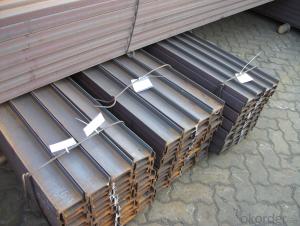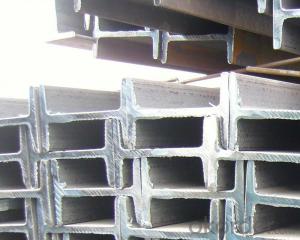IPE/ IPEAA steel beam
- Loading Port:
- Tianjin
- Payment Terms:
- TT OR LC
- Min Order Qty:
- 2000 m.t.
- Supply Capability:
- 20000 m.t./month
OKorder Service Pledge
OKorder Financial Service
You Might Also Like
Product Description:
Specifications of I BEAM European standard of IPE and IPEAA
size | Kg/m |
IPE 100*55*4.1 | 8.1 |
IPEAA 100*55*3.6 | 6.72 |
IPE 120*64*4.4 | 10.4 |
IPEAA 120*64*3.8 | 8.36 |
IPE 140*73*4.7 | 12.9 |
IPEAA 140*73*3.8 | 10.05 |
IPE 160*82*5.0 | 15.8 |
IPEAA 160*82*4 | 12.31 |
IPE 200*100*5.6 | 22.4 |
IPEAA 200*100*4.5 | 17.95 |
Grade: Q235B, Q235, Q345B, SS400, A36 etc
Standard: EN standard etc
Length: 6m, 12m, or as the customers’ requirements.
Usage of I BEAM European standard of IPE and IPEAA :
1.Support structures 2.Pre-engineered buildings 3.Prefabricated structure
4.It is widely used in various building structures and engineering structures such as roof beams, bridges, transmission towers, hoisting machinery and transport machinery, ships, industrial furnaces, reaction tower, container frame and warehouse etc.
Payment terms: TT or LC.
Package: packed in bundles and then shipped by break bulk or containers.
- Q: Can steel I-beams be used for telecommunications infrastructure?
- No, steel I-beams are not typically used for telecommunications infrastructure. Telecommunications infrastructure typically requires lighter materials that can support the installation of equipment such as antennas and cables. Steel I-beams are more commonly used in construction for their strength and load-bearing capabilities.
- Q: Can steel I-beams be used in airport terminals?
- Yes, steel I-beams can be used in airport terminals. They are commonly used for structural support in building construction, including airport terminals, due to their strength and durability.
- Q: What are the common architectural finishes available for steel I-beams?
- Some common architectural finishes available for steel I-beams include painting, galvanizing, powder coating, and epoxy coating. These finishes enhance the aesthetic appeal of the beams and also provide protection against corrosion and environmental factors.
- Q: What are the different types of steel I-beam connections for truss systems?
- There are several types of steel I-beam connections that are commonly used in truss systems. These connections are designed to provide stability and strength to the overall structure. Some of the different types of steel I-beam connections for truss systems include: 1. Welded Connections: This is one of the most common types of connections used in steel truss systems. It involves welding the I-beam to other structural components, such as plates or other beams, to create a strong and rigid connection. Welded connections are known for their durability and ability to withstand heavy loads. 2. Bolted Connections: Bolted connections involve using bolts and nuts to secure the I-beams together. This type of connection allows for easy assembly and disassembly, making it a popular choice for temporary or movable truss systems. Bolted connections also provide flexibility in terms of adjusting the position or angle of the I-beams. 3. Riveted Connections: Riveted connections are similar to bolted connections but use rivets instead of bolts. Rivets are inserted through pre-drilled holes in the I-beams and then hammered or pressed to create a permanent connection. Riveted connections are known for their high strength and resistance to shear forces. 4. Gusset Plate Connections: A gusset plate is a steel plate that is used to connect two or more I-beams at their intersection points. The plate is typically welded or bolted to the beams, providing additional strength and stability to the truss system. Gusset plate connections are commonly used in complex truss designs or when specific load requirements need to be met. 5. Cleat Connections: Cleat connections involve attaching a steel plate, known as a cleat, to the top or bottom flange of the I-beam. The cleat is then bolted or welded to another structural component, such as a column or another beam. Cleat connections are often used in situations where the I-beams need to be connected at an angle or when additional support is required. Overall, the choice of steel I-beam connection for a truss system depends on various factors, including the load requirements, structural design, and ease of assembly. It is important to consult with a structural engineer or professional to determine the most suitable connection type for a specific truss system.
- Q: How do steel I-beams perform in high-temperature bridge applications?
- Steel I-beams perform well in high-temperature bridge applications due to their inherent high strength and excellent fire resistance properties. The structural design of I-beams allows them to withstand substantial loads and provide stability in extreme conditions, including high temperatures. One of the main reasons steel I-beams are suitable for high-temperature bridge applications is their ability to maintain their structural integrity at elevated temperatures. Unlike other materials like wood or concrete, steel retains its strength and does not degrade significantly under high heat. This is crucial in bridge construction as it ensures the safety and reliability of the structure even in extreme conditions. Moreover, steel I-beams have a high melting point, making them resistant to heat-related deformations. This allows the bridge to maintain its shape and structural stability even when exposed to intense heat. Additionally, steel's low thermal expansion coefficient minimizes the risk of structural distortion caused by temperature fluctuations. In the event of a fire, steel I-beams also provide excellent fire resistance. Steel is non-combustible and does not contribute to the spread of fire, giving it an advantage over other materials. Furthermore, steel's high thermal conductivity helps dissipate heat quickly, preventing localized overheating and reducing the risk of structural failure. To enhance the performance of steel I-beams in high-temperature bridge applications, certain measures can be taken. For instance, the steel can be coated with fire-resistant materials, such as intumescent paint or fireproof insulation, to provide an additional layer of protection against high temperatures. Additionally, fire-resistant barriers can be incorporated into the bridge design to contain potential fires and limit their impact on the structure. In conclusion, steel I-beams are highly suitable for high-temperature bridge applications due to their inherent strength, fire resistance, and ability to withstand extreme conditions. Their structural integrity, resistance to heat-related deformations, and excellent fire resistance make them a reliable choice for constructing bridges that can withstand high temperatures and ensure the safety of the infrastructure and its users.
- Q: Can steel I-beams be used for parking structures?
- Indeed, parking structures can utilize steel I-beams. In construction projects, steel I-beams are widely employed owing to their robustness and longevity. They possess the capability to withstand heavy loads, making them well-suited for parking structures that require accommodation for multiple vehicles. Moreover, the fabrication and assembly of steel I-beams are effortless, providing flexibility in both design and construction. By incorporating steel I-beams into parking structures, one can create wide, open spaces without the necessity of excessive columns or support structures, thereby maximizing available parking space. In summary, due to their structural integrity, cost-effectiveness, and ability to meet weight requirements, steel I-beams are a popular choice for parking structures.
- Q: How do steel I-beams contribute to the overall architectural design of a structure?
- Steel I-beams contribute to the overall architectural design of a structure by providing structural support and creating open and spacious interiors. They are used to carry heavy loads and distribute weight efficiently, allowing for the construction of large, open spaces without the need for excessive supporting columns or walls. The use of steel I-beams also enables architects to design buildings with unique and striking aesthetics, as they can be exposed and incorporated into the overall design, showcasing the industrial and modern appeal of the structure.
- Q: What are the safety considerations when working with steel I-beams?
- When working with steel I-beams, safety considerations include ensuring proper lifting techniques and equipment are used to prevent accidents or injuries, wearing appropriate personal protective equipment such as gloves and safety goggles, inspecting the beams for any defects or damage before use, securing the beams properly to prevent them from falling or shifting during installation or transportation, and following proper procedures for cutting or welding steel beams to prevent fire hazards. Additionally, it is important to be aware of the weight and size of the beams to avoid overexertion or strain while handling them.
- Q: Use I-beam to make the beam, and then add a piece of steel plate, steel plate and then play cast, so do it?
- The steel beam and the two ends of the structure can be hinged, and the embedded parts shall be finished well.The main problem of steel beams is corrosion protection, which can be maintained regularly with anticorrosive paint.
- Q: Can steel I-beams be used for automotive manufacturing plants?
- Indeed, automotive manufacturing plants can utilize steel I-beams for their construction needs. These I-beams are widely employed in the field of construction due to their exceptional strength and durability, rendering them suitable for bearing substantial loads. In the context of automotive manufacturing plants, they serve as a prime choice for establishing the fundamental structure of the facility, which encompasses the roof, walls, and floors. Moreover, they prove invaluable in constructing robust support frameworks for overhead cranes and conveyors, which play a crucial role in maneuvering heavy automotive components and equipment. Furthermore, these steel I-beams can be effectively employed in creating mezzanine levels or platforms within the plant, thereby providing supplementary space for storage or assembly lines. In summary, the utilization of steel I-beams in automotive manufacturing plants is a prudent decision, as they offer unparalleled structural stability and can effortlessly withstand the rigorous demands of the industry.
Send your message to us
IPE/ IPEAA steel beam
- Loading Port:
- Tianjin
- Payment Terms:
- TT OR LC
- Min Order Qty:
- 2000 m.t.
- Supply Capability:
- 20000 m.t./month
OKorder Service Pledge
OKorder Financial Service
Similar products
Hot products
Hot Searches
Related keywords



























